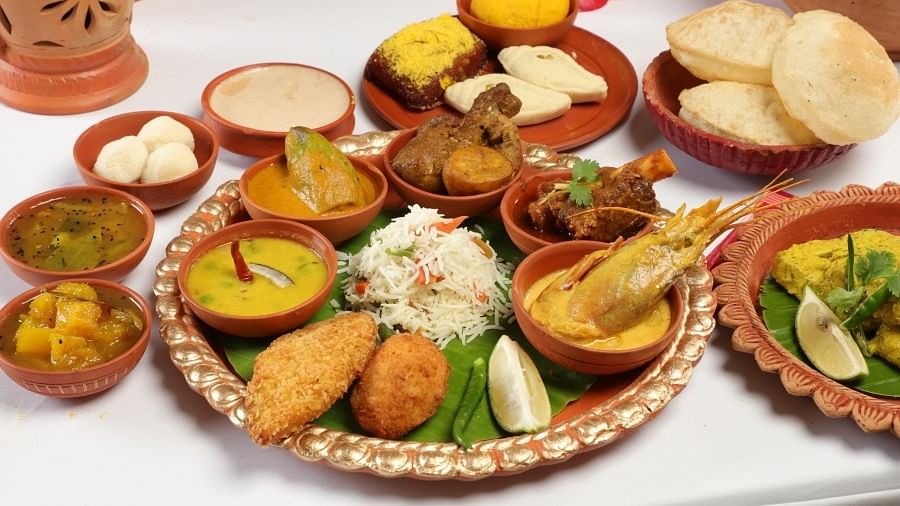
Pujo platter.
Credit: JW Marriott, Kolkata
Few sharing the table with Nabakrishna Deb, a wealthy zamindar from Calcutta (now Kolkata), and his special guest, Colonel Robert Clive, would have imagined the history they were making on his maiden Durga Utsav, let alone the worldwide cultural spectacle that a traditional puja would transform into. The opulence, exquisite furnishings, a stunning idol, a feast fit for a king prepared by the famed pandas of Puri, and a cannon fired to commemorate the demon’s slaughter were all part of the works.
It was 1757, after the disastrous Battle of Plassey, which ultimately led to the British colonisation, and a century or so since the debut of Durga Utsav conducted first by Raja Kangsha Narayan of Tahirpur in Bangladesh (1583) and then by Laxmikant Ganguly of Barisha (1610) — the latter following the Shakta tradition of offering illish to the Goddess.
A community food fiesta
None could have predicted the culinary grandeur that this simple festival, often a ruse of feeding people during the famine, would eventually become.
Not even by 1918, when the Rajbari festival became Sarbajanin with Baghbazar Sarbajanin Durgotsav thanks to the 12 revolutionaries (Barowari) who organised the first of the kind or when Rabindra Nath Tagore and Subhash Chandra Bose used it to bring communities, including the once-barred Muslim brethren, together.
After all, throughout Durga puja’s history, the festival’s focus remained on serving bhog, which includes khichuri, bhaja, labra, chutney, and payesh on the seventh, eighth, and ninth days, with one day set out for meat or its equivalent.
When did the celebration that gave Bal Gangadhar Tilak the idea to organise the Ganesh Utsav in Maharashtra receive its medal for being a food fiesta? One that could turn a city into a gourmet destination as well as the environs around the pandal?
The key to this mystery remains unresolved. Some, like Chef Sumanta Chakrabarti, believe it was added after the independence when “Durga puja, courtesy immigration, began to be celebrated across different parts of the world including Taiwan, where communities would participate by putting these small stalls that doled out popular fare, some that were unique to their culture and some that were a result of the meeting of two different culinary traditions.” Some others, like Chef Sabyasachi Gorai, believe it was the work of the Anandabazar that encouraged women to sell home-cooked delicacies and was a part of the Swadeshi Mela put together by Bose to promote Indian-made products.
For Koyel Roynandi of Sienna Store and Cafe, the curation was a result of Calcutta being Calcutta itself. “It is a city of virtues, first as an important port town (ice landed here first) and then as the colonial capital, that made it into this rich melting pot of cuisines and food that were created by the different influences that happened in a different era,” adds Koyel.
Therefore, when Durga puja became Sarbajanin, the fusion of the many cuisine cultures was inevitable.
The first incarnation of the gastronomic extravaganza, according to Chef Sumanta, took place “inside the Rajbari itself, when Durga puja was much more of an aristocratic social gathering reserved for the gora babus and peers. Cooks were then employed to provide unique dishes that would not only appeal to the guests but also follow fashion trends.
It was normal practice to employ cooks of various racial and ethnic backgrounds who could contribute to making a spread that would be the talk of the neighbourhood.
As a result, the table, while largely Niramish (fleshless), featured influences from several communities that had called Calcutta, home. There were kaliya and kormas from the Mughals, malai curries from Bangla cooks, chaat, puchkas from Biharis, dal torka and tandooris from the Sikhs, stews created by Anglo-Indian cooks, mithais from the Jains and so on.
The influences
While it is true, says Bengali food historian Pritha Sen, “that much of the culinary foreplay that we enjoy today had its genesis at the rajbari of zamindars in and around the puja, which was used to curry favours from the colonial masters including tax relief on account of hosting a lavish Durga puja, much of what we see today was also the work of the three different styles of puja — Vaishnav, Shakta and Tantrik — that gave the celebration its motherboard menu.
While the Vaishnav style was all vegetarian from where we got the sweets, khichuri, labra and the original wood apple chutney, the Tantrik style allowed for meat and wine, while the more popular Shakta practice brought in the use of fish, especially illish that was offered to the goddess as prasad, and the tradition of welcoming Ma Durga, who took on the avatar of a homecoming married daughter, with narku or sweets made of Bengal gram. Between them, the bali and Niramish Mangsho traditions also evolved, giving Durga puja celebration meals their comprehensive syntax and definition in the process.” By the turn of the century, says Sen, “communities like the Chinese, Jews, and others who had once made Calcutta their home under the patronage of the British, too, became a part of the puja culture and often would have stalls doling out popular fares like chowmein, stews, and soup that were a result of the intermarriage of two food cultures.”
While much of the food fanfare one witnesses around the celebration today has been the city’s age-old foodie nature, economics too has played an equal role in turning Kolkata into a foodie’s paradise. But it wasn’t till Durga Utsav became a community celebration that the different eras came together to display the rich heritage turning the city into a gourmet destination — at least for these very five days.
(The author is a seasoned food columnist and curator of experiential dining experiences, pop-ups, and retreats for chefs)